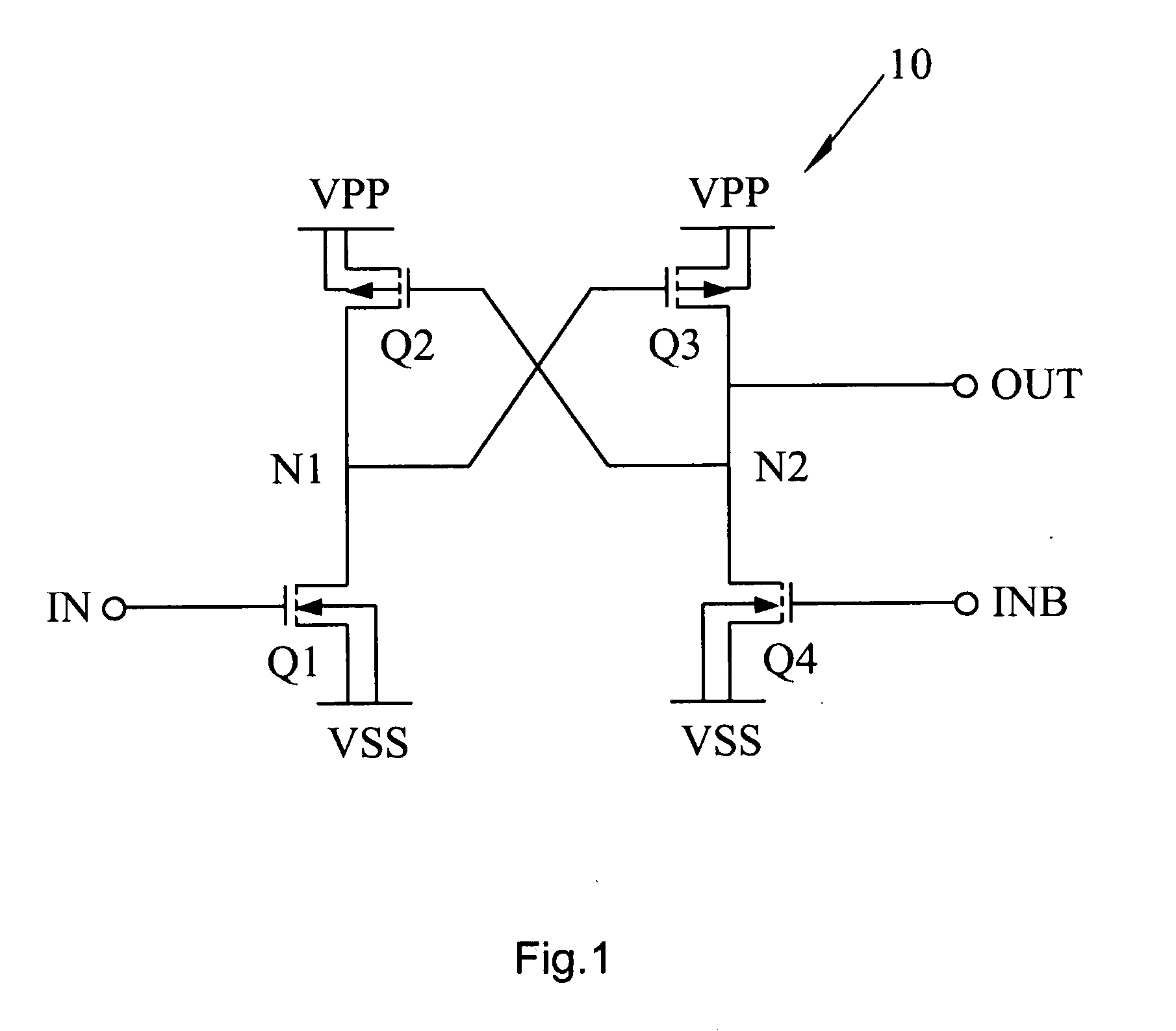Level shifter circuit
a shifter circuit and level technology, applied in the direction of pulse generators, pulse techniques, electrical apparatus, etc., can solve the problem of increasing the complexity of layout design, and achieve the effect of avoiding hot-carrier degradation and minimizing leakage curren
- Summary
- Abstract
- Description
- Claims
- Application Information
AI Technical Summary
Benefits of technology
Problems solved by technology
Method used
Image
Examples
first embodiment
[0021]FIG. 2 is a positive 4-transistor level shifter circuit 20 according to the present invention. Such level shifter circuit 20 comprises two N-type transistors Q1 and Q4 provided at the side of a reference voltage VSS, e.g. grounded voltage, and receiving, through the use of an inverter (not shown), complementary input signals from an input terminal IN and an input terminal INB, respectively. Both inputs being supplied by a row decoder for example. Two P-type transistors Q2 and Q3 are provided at the side of a power supply voltage, e.g. programming voltage VPP, generated by an on-chip charge pump for example. The cross-coupled transistors Q2 and Q3 constitute a flip-flop wherein the gate terminal of each transistor is connected to the drain terminal of the other at a series-connection node N2 of the transistors Q3 and Q4 and at a series-connection node N1 of the transistors Q1 and Q2, respectively. The substrate and source terminal of each of them is connected to the power suppl...
second embodiment
[0025]FIG. 3 is a positive 6-transistor level shifter circuit 30 according to the present invention. Such level shifter circuit 30 comprises two N-type transistors Q1 and Q4 provided at the side of a reference voltage VSS, e.g. grounded voltage, and receiving, through the use of an inverter (not shown), complementary input signals from an input terminal IN and an input terminal INB, respectively. Both inputs are supplied by a row decoder for example. Two P-type transistors Q2 and Q3 are provided at the side of a power supply voltage, e.g. programming voltage VPP, generated by an on-chip charge pump for example, and two additional P-type transistors Q5 and Q6 coupled between the transistors Q1 and Q2 for Q5 and Q3 and Q4 for Q6. The gates of the transistors Q2 and Q3 are cross-connected to the series-connection nodes N4 of the transistors Q4 and Q6 and to the series-connection node N3 of the transistors Q1 and Q5, respectively. The substrate of the transistors Q2, Q3, Q5 and Q6 is co...
PUM
 Login to View More
Login to View More Abstract
Description
Claims
Application Information
 Login to View More
Login to View More - R&D
- Intellectual Property
- Life Sciences
- Materials
- Tech Scout
- Unparalleled Data Quality
- Higher Quality Content
- 60% Fewer Hallucinations
Browse by: Latest US Patents, China's latest patents, Technical Efficacy Thesaurus, Application Domain, Technology Topic, Popular Technical Reports.
© 2025 PatSnap. All rights reserved.Legal|Privacy policy|Modern Slavery Act Transparency Statement|Sitemap|About US| Contact US: help@patsnap.com



